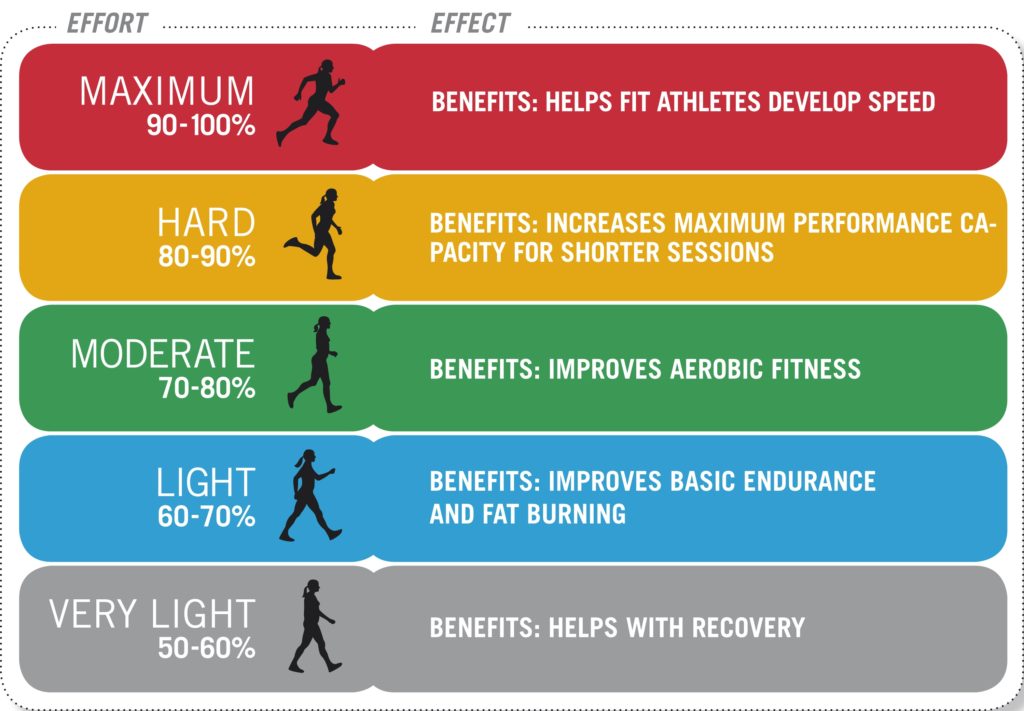
Introduction:
Utilizing a heart rate monitor during training sessions can really help you get the most out of each session. Every session should have a designated goal. A good training plan will incorporate a variety of different workouts. Speed sessions should be difficult, tempo runs should be comfortably hard, long runs should be relatively comfortable, and recovery runs should feel easy. Heart rate training ensures that you are in control of your sessions and not pushing too hard on easy days.
Benefits:
Heart rate training has an advantage over training by pace in the sense that your pace may change. For example, when you run up a hill, your pace will usually decrease. Vice versa, when you run down a hill, your pace will naturally quicken. Weather may also affect your pace; trying to run a 7 minute mile during a heatwave may be a tough ask. This is where heart rate training would allow you to slow down to adjust, whilst remaining in the required heart rate zone.
Monitoring your heart rate also ensures that you aren’t racing every training run and burning yourself out. It can allow you to incorporate some easier runs into your training. Training in zone 2 for long runs is also recommended for endurance athletes as it builds the aerobic base. This base acts as the foundation for building threshold fitness.
Essentially, heart rate training allows you to get the most out of every training session. It ensures that you go easy enough on recovery or long run days, but also that you are pushing yourself adequately during speed workouts or hill training sessions.
What You’ll Need:
Before you can start heart rate training, you will need to invest in a heart rate monitor. Most sports watches come with an optical heart rate sensor built in (wrist sensor), however if you are serious about using your heart rate data, I would advise investing in a chest heart rate monitor. I use a Garmin 945 watch (review) and pair it with a Garmin HRM-Run strap. Optical sensors can be a bit hit or miss, especially during interval sessions as they take a while to register an increase in heart rate. There are other options, such as Bluetooth chest straps, or even armband straps (the Scosche Rhyme+ is highly rated amongst runners).
Configuring Zones:
Once you have a heart rate monitor you need to set up your heart rate zones. There are a number of different ways to configure heart rate zones. Either using a percentage of maximum heart rate, a percentage of lactate threshold, or percentage of heart rate reserve.
Percentage of Maximum Heart Rate (%MHR)
You may have heard of the most common way of working out your maximum heart rate is to take 220 and minus your age. So, for me that would be 220 – 28, meaning that my maximum heart rate would be 192. This, however, is clearly not the most accurate method! A better approach would be to complete a lengthy warm up and then run as hard as you can for 3 minutes, rest for 3 minutes and repeat this until you have completed 3 runs. If possible, it would be best to complete this on a treadmill so that you have more control over the speed, and also because your heart rate will usually be higher indoors. Once complete, you take the highest reading and use that as your maximum heart rate. Alternatively, you could race a 5k at an all-out effort and then take your highest heart rate reading from that.
This is a good option for those who are inexperienced exercisers, or who are new to heart rate training. It’s the simplest option to understand and also needs to the least information to configure.
Percentage of Lactate Threshold Heart Rate (%LTHR)
To calculate your lactate threshold heart rate, you will need to complete a solo 30 minute time-trial. It should be ran as if you were racing for the entire 30 minutes; however, after the initial 10 minutes, click the lap button on your heart rate monitor. When you have finished the run, your average heart rate for the last 20 minutes of the run is your approximate lactate threshold heart rate. It’s important to give a solid, but consistent effort across the 30 minutes. Be wary of setting out too fast and being unable to hold the pace for the remainder of the duration.
This method is a good option for those who have been training with a fitness tracker for a while as you have more insight into your heart rate average across previous activities. As you get fitter, your lactate threshold will improve. A lot of newer Garmin watches will give you a notification when your lactate threshold heart rate has improved so that you can amend your zones accordingly.
Percentage of Heart Rate Reserve (%HRR)
To utilize percentage of heart rate reserve training, you need to know your average resting heart rate. My Garmin tracks this daily and automatically updates my average resting heart rate for me. If your watch or tracker doesn’t offer this information, you can manually check your heart rate first thing in the morning for a week or so to get an idea of an average number.
This is the method that I’m personally using at the moment, and have been for a while. Like the percentage of lactate threshold method, this method requires an average of information over a timescale as your resting heart rate can vary day by day. If you have been tracking your heart rate using a watch or activity tracker for a while, then you may already have sufficient data to start out with this method. Otherwise, it may be best to start with the percentage of maximum heart rate method until you can generate a more accurate average resting heart rate.
Heart Rate Zones:
Each heart rate zone has its own training benefits, so it’s important to incorporate different types of training activities that utilize each zone:
- Zone 1 – recovery runs, flushing out legs, can be alternated with cross training, 4 out of 10 RPE, social runs. 50-60% of Max HR. <85% of Lactate Threshold HR. 51-63% of Heart Rate Reserve
- Zone 2 – aerobic base building, burns fat – 5 or 6 RPE, can hold a conversation comfortably. 60-70% of Max HR. 85-89% of Lactate Threshold HR. 63-74% of Heart Rate Reserve
- Zone 3 – muscular endurance and build efficiency, “grey area” – not hard enough for anaerobic training but too hard for pure aerobic base building – 7 RPE – short sentences. 70-80% of Max HR. 90-94% of Lactate Threshold HR. 74-81% of Heart Rate Reserve
- Zone 4 – hard work – 8 RPE, won’t feel comfortable, improves lactate threshold and speed endurance, essential for building speed. 80-90% of Max HR. 95-99% of Lactate Threshold HR. 81-87% of Heart Rate Reserve
- Zone 5 – can’t hold this zone long, 10 out of 10 effort, builds lactic acid quickly and causes fatigue, best for sprint finishes. 90-100% of Max HR. 100-106% of Lactate Threshold HR. 87-100% of Heart Rate Reserve

Conclusion:
Understanding and setting up custom heart rate zones may seem confusing, but it’s definitely beneficial in the long run (pardon the pun!). Your heart rate can tell you a lot and can be used to monitor your fitness levels. If your fitness is increasing then your heart rate would be lower for the same pace. Your resting heart rate will also decrease as your fitness improves. Heart rate training ensures that you don’t push yourself too hard on your runs, as it’s typically recommended that 80% of your mileage should be at an “easy” zone 2 pace.




Amazing piece of information yts